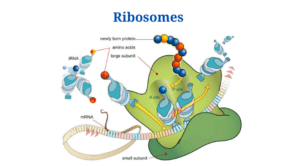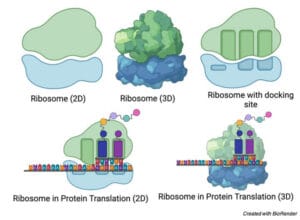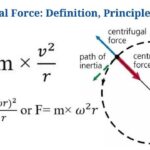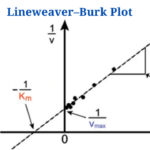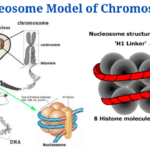Definition of Ribosomes
- The name ribosome is derived from two words: ribonucleic acid and ‘somes’, which is derived from the Greek word soma, which meaning “body.”
- Ribosomes are dense spheroidal particles with a diameter of 150 to 200 A0 found in most bacterial and eukaryotic cells.
- Protein synthesis takes place at these locations.
- They’re RNA and protein-rich structures that operate as a scaffold for the orderly interaction of the many molecules involved in protein synthesis.
- Ribosomes can be present in both bacterial and eukaryotic cells.
- Ribosomes are frequently found freely in the cytoplasm of bacterial organisms.
- Ribosomes are found either freely in the cytoplasm or connected to the outer surface of the endoplasmic reticulum membrane in eukaryotic cells.
- What kind of protein a cell produces is determined by the location of its ribosomes.
- If the ribosomes are free to move around the cell, they will produce proteins that will be used by the cell.
- Rough endoplasmic reticulum, or rough ER, is formed when ribosomes are connected to the endoplasmic reticulum.
- Proteins produced on the rough ER can be utilised both inside and outside the cell.
- The amount of ribosomes in a cell is determined by the cell’s activity.
- A mammalian cell can have up to 10 million ribosomes on average.
Ribosomes’ Structure
- A ribosome is a ribonucleoprotein because it is made up of RNA and protein complexes.
- RNA makes up 37 to 62 percent of RNA, whereas proteins make up the balance.
- Each ribosome is divided into two parts:
- A smaller one that binds to a larger one and the mRNA pattern.
- A larger one that binds to the tRNA, amino acids, and the smaller one.
- Prokaryotes have 70S ribosomes, which are divided into two subunits: the smaller 30S subunit and the larger 50S subunit.
- A 16S RNA subunit (containing of 1540 nucleotides) is coupled to 21 proteins in their small subunit.
- The large subunit is made up of a 5S RNA subunit (120 nucleotides), a 23S RNA subunit (2900 nucleotides), and 31 proteins.
- Eukaryotes have 80S ribosomes, which are made up of 40S and 60S subunits, respectively.
- One molecule of 18S ribosomal RNA (or rRNA) and 30 proteins make up the 40S ribosomal subunit, which is shaped like a prolate ellipsoid (named as S1, S2, S3, and so on).
- The bigger 60S ribosomal subunit is shaped like a cylinder and has a channel via which the expanding polypeptide chain exits.
- It is made up of 40 proteins and three types of rRNA molecules: 28S rRNA, 5.8 rRNA, and 5S rRNA (named as L1, L2, L3 and so on).
- Antibiotics that kill bacteria without hurting human cells are developed using the distinctions between bacterial and eukaryotic ribosomes.
- Ribosomes in chloroplasts and mitochondria of eukaryotes are made up of large and tiny subunits made up of proteins inside a 70S particle.
- Despite their variances in size, all ribosomes have a basic structure that is comparable.
- During protein synthesis, the two subunits fit together and work together to convert mRNA into a polypeptide chain.
- They are somewhat longer in the axis than in diameter because they are made up of two non-equal-sized subunits.
- A polysome is a structure formed when numerous ribosomes are coupled to the same mRNA strand during protein synthesis.
- Ribosomes are only present for a short time; following polypeptide synthesis, the two subunits split and are reused or broken up.
Types of ribosomes
(a) Ribosomes in Prokaryotes
Bacteria, like E. coli, possess more than 15,000 ribosomes (in proportions this equals almost a quarter of the dry weight of the bacterial cell).
The ribosomes in bacteria are about 18nm in diameter and consist of 65% ribosomal RNA and only 35% proteins of various sizes, between 6,000 and 75,000 kDa.
The large subunit is called 50S and the small 30S, which combine to form a 70S structure with a molecular mass of 2.5 × 106 kDa.
The 30S subunit is elongated in shape and not symmetrical, while the 50S is thicker and shorter.
The small E. coli subunit is made up of 16S ribosomal RNAs (1542 bases) and 21 proteins and in the large subunit are 23S ribosomal RNAs (2904 bases), 5S (1542 bases) and 31 proteins. The proteins that compose them are basic and the number varies according to the structure.
Ribosomal RNA molecules, along with proteins, are grouped into a secondary structure similarly to other types of RNA.
(b) Ribosomes in Eukaryotes
Ribosomes in eukaryotes (80S) are larger, with higher RNA and protein content. RNAs are longer and are called 18S and 28S. As in prokaryotes, the composition of ribosomes is dominated by ribosomal RNA.
In these organisms, the ribosome has a molecular mass of 4.2 × 106 kDa and breaks down into the 40S and 60S subunits.
The 40S subunit contains a single RNA molecule, 18S (1874 bases) and some 33 proteins. Likewise, the 60S subunit contains the 28S (4,718 bases), 5.8S (160 bases) and 5S (120 bases) RNAs. Furthermore, it is made up of basic proteins and acidic proteins.
(c) Ribosomes in Archaea
Archaea are a group of microscopic organisms that resemble bacteria, but differ in so many characteristics that they constitute a separate domain. They live in diverse environments and are capable of colonizing extreme environments.
The types of ribosomes found in archaea are similar to the ribosomes of eukaryotic organisms, although they also have certain characteristics of bacterial ribosomes.
It has three types of ribosomal RNA molecules: 16S, 23S and 5S, coupled to 50 or 70 proteins, depending on the study species. Regarding the size, the ribosomes of archaea are closer to the bacterial ones (70S with two subunits 30S and 50S) but in terms of their primary structure they are closer to the eukaryotes.
Since archaea usually inhabit environments with high temperatures and high salt concentrations, their ribosomes are highly resistant.
Ribosomes Functions
- The ribosome is a complicated molecular machine that is found in all living cells and is responsible for the production of biological proteins (translation).
- Messenger RNA (mRNA) molecules direct the order in which ribosomes connect amino acids together.
- Peptidyl transfer and peptidyl hydrolysis are two critically
Click Here for Complete Biology Notes
Ribosomes Citations
- Alberts, B. (2004). Essential cell biology. New York, NY: Garland Science Pub.
- Kar,D.K. and halder,S. (2015). Cell biology genetics and molecular biology.kolkata, New central book agency
- https://biology.tutorvista.com/animal-and-plant-cells/ribosomes.html
- https://alevelbiology.co.uk/notes/ribosomes-structure-and-functions/
- https://biologywise.com/ribosomes-function
- https://biologydictionary.net/ribosome/
Related Posts
- Phylum Porifera: Classification, Characteristics, Examples
- Dissecting Microscope (Stereo Microscope) Definition, Principle, Uses, Parts
- Epithelial Tissue Vs Connective Tissue: Definition, 16+ Differences, Examples
- 29+ Differences Between Arteries and Veins
- 31+ Differences Between DNA and RNA (DNA vs RNA)
- Eukaryotic Cells: Definition, Parts, Structure, Examples
- Centrifugal Force: Definition, Principle, Formula, Examples
- Asexual Vs Sexual Reproduction: Overview, 18+ Differences, Examples
- Glandular Epithelium: Location, Structure, Functions, Examples
- 25+ Differences between Invertebrates and Vertebrates
- Lineweaver–Burk Plot
- Cilia and Flagella: Definition, Structure, Functions and Diagram
- P-value: Definition, Formula, Table and Calculation
- Nucleosome Model of Chromosome
- Northern Blot: Overview, Principle, Procedure and Results

